A Novel Seventh-Order Implicit Block Hybrid Nyström-Type Method for Second-Order Boundary Value Problems
- Joel Olusegun Ajinuhi
- Umaru Mohammed
- Abdullah Idris Enagi
- Jimoh Omananyi Razaq
- -44
- Nov 28, 2023
- Information and Communication Technology
A Novel Seventh-Order Implicit Block Hybrid Nyström-Type Method for Second- Order Boundary Value Problems
Joel Olusegun Ajinuhi*, Umaru Mohammed, Abdullah Idris Enagi, Jimoh Omananyi Razaq
Department of Mathematics, Federal University of Technology, Minna, Niger State, Nigeria
DOI: https://doi.org/10.51244/IJRSI.2023.1011003
Received: 09 October 2023; Revised: 23 October 2023; Accepted: 26 October 2023; Published: 28 November 2023
ABSTRACT
This paper introduces a novel approach for solving second-order nonlinear differential equations, with a primary focus on the Bratu problem, which holds significant importance in diverse scientific areas. Existing methods for solving this problem have limitations, prompting the development of the Block Hybrid Nystrom-Type Method (BHNTM). BHNTM utilizes the Bhaskara points derived, using the Bhaskara cosine approximation formula. The method seeks a numerical solution in the form of a power series polynomial, efficiently determining coefficients. The paper discusses BHNTM’s convergence, zero stability, and consistency properties, substantiated through numerical experiments, highlighting its accuracy as a solver for Bratu-type equations. This research contributes to the field of numerical analysis by offering an alternative, effective approach to tackle complex second-order nonlinear differential equations, addressing critical challenges in various scientific domains.
Keywords: Hybrid Method; Block Nyström-type method; Nonlinear ODEs; Power Series Polynomials; One-dimensional Bratu problems.
INTRODUCTION
In this paper, we develop a one-step hybrid block Nystrom-type method as a computing strategy for solving a class of second order nonlinear differential equations given as:
defined on the close interval [0,1] subject to the following boundary conditions:
y(0)=y(1)=0, (1.2)
where λ(x) and μ(x) are some known continuous functions of x. The problem given above arises in modelling of electrically conducting solids – Wazwaz & Suheil (2013). The case μ = 1 in the above equation arises in the analysis of Joule losses in electrically conducting solids, λ represents square of the constant current and ey models the temperature dependent resistance. In the case of fractional heating, λ represents square of the constant shear stress and ey models temperature dependent fluidity.
Bratu’s equation is a special form of equation (1.1) where the functions λ(x) and μ(x) are constants. Its general form is given as:
The associated initial and boundary conditions, respectively, are given as:
where μ is taken as +1 or -1, y(x) is the solution of the equation, and λ is a real parameter. This two-point boundary value problem is a special case in the modelling of electrically conducting solids, and also occurs in diffusion theory (see, Wazwaz & Suheil, 2013; Frank-Kamenetski, 1955). Equation (1.3) with initial and boundary conditions also arises in many physical models such as the fuel ignition model in combustion theory, model of thermal reaction processes in chemical reaction theory, the Chandrasekhar model of the expansion of the universe, questions in geometry and relativity concerning the Chandrasekhar model, radiative heat transfer, and nanotechnology (Frank- Kamenetski, 1955; Bratu, 1914; Gelfand, 1963; Jacobsen & Schmitt, 2002; Hariharan & Pirabaharan, 2013). The Bratu problem came to light with Bratu’s article published in 1914, Bratu (1914). In honour of Gelfand and the French mathematician Liouville, Gelfand (1963); it is also known as the ‘‘Liouville-Gelfand’’ or ‘‘Liouville-Gelfand-Bratu’’ problem. Jacobsen and Schmitt have provided an excellent summary of the significance and history of Bratu-type equations – Jacobsen & Schmitt (2002). In recent years, this problem has become a popular benchmark to test the accuracy of various numerical solvers. Buckmire (2004), Mounim & de Dormale (2006); numerical approaches based on Hybrid Block Nystrom-type method however have received very minimal attention for the solution of these special kinds of BVPs.
Therefore, Bratu-type problem is of great scientific importance and several numerical methods have been developed to find the approximate solution. For instance, the differential transformation method given in Hassan & Erturk (2007), the multigrid-based methods in Mohsen (2014), iterative numerical scheme based on the Newton’s Kantorovich method in function space in Temimi & Ben-Romdhane (2016), the decomposition method in Deeba et al. (2000) have been adopted to solve the Bratu’s problem. Other methods such as the modified wavelet Galerkin method given in Raja et al. (2015), the Laplace Adomian decomposition method, the perturbation-iteration method, the Lie-group shooting method and the integral solution via Greens function have been used to solve Bratu’s problem as seen in Temimi & Ben-Romdhane (2016). The feed-forward artificial neural networks (ANN) optimized with genetic algorithm (GA) and the active-set method (ASM) was adopted to solve a number of initial and boundary value problems based on Bratu equations, Raja et al. (2016). The standard Nystrom-type method is used to solve only initial value problems of ordinary differential equations in practical terms. In this paper, the Block Hybrid Nystrom-Type Method (BHNTM) is constructed by introducing hybrid points derived using the Bhakara Cosine Approximation formula to obtain a numerical solution for the classical one-dimensional Bratu’s problem by extending the work of Jator and Manathunga (2018). The paper is organized as follows. In section 2, the BHNTM is derived and its basic properties of convergence, zero stability and consistency in section 3. In section 4, the description of the implementation strategy as well as the execution of the numerical experiments and discussion of results. Finally, the conclusion of the paper is discussed in section 5.
DEVELOPMENT OF THE BHNTM
Consider the problem
Subject to the following conditions on :
i.  is continuous,
is continuous,
ii. derivative of  exist and continuous.
exist and continuous.
considering also the problem on the interval [a, b], such that the partitioning is done using the Bhaskara cosine approximation formula to generate the Bhaskara points which in turn is used to develop the algorithm by approximating the cosine functions  where
where  , the number
, the number  is referred to as the constant step size. Supposing the exact solution is approximated by the power series polynomial of the form
is referred to as the constant step size. Supposing the exact solution is approximated by the power series polynomial of the form
where aj are coefficients obtained distinctly and  , for some natural number n . In order to determine the coefficients aj , the following conditions hold:
, for some natural number n . In order to determine the coefficients aj , the following conditions hold:
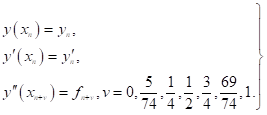 (2.3)
(2.3)Differentiating (2.2) once and twice gives
 (2.4)
(2.4)Using equations (2.2) and (2.4) on the criteria given in (2.3) a system of nonlinear equations of the form are obtained
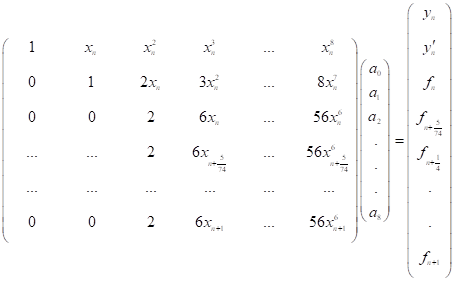 (2.5)
(2.5)The above system of nonlinear equations is solved using the matrix inversion algorithm. The unknown coefficients aj, are then substituted into (2.2) to derive the continuous Hybrid Block Nystrom-type Method with five off-step points (BHNTM1,5):
 (2.6)
(2.6)and
where  are continuous coefficients that are distinctly determined. Assuming that yn is the numerical approximation to the analytical solution
are continuous coefficients that are distinctly determined. Assuming that yn is the numerical approximation to the analytical solution 
 is the numerical approximation to
is the numerical approximation to  is the numerical approximation to
is the numerical approximation to 
The main methods are obtained by evaluating (2.6) at points  to give the discrete schemes which form the continuous block hybrid Nystrom-type method with five off-grid points:
to give the discrete schemes which form the continuous block hybrid Nystrom-type method with five off-grid points:
 (2.8)
(2.8)The additional methods are obtained by evaluating (2.7) at  to give the following discrete schemes:
to give the following discrete schemes:
 (2.9)
(2.9)ANALYSIS OF THE BHNTM
In this section, mathematical analysis on some basic properties of the derived schemes are discussed extensively. Existing definitions and theorems well support these properties.
3.1 Order and Error Constant
The proposed BHNTM of (2.8) and (2.9) is classified as a member of the linear multistep method (LMM) which can be represented generally as
Definition 1 (Rufai and Ramos, 2020).
Associated with a numerical method is a linear difference operator η which is supposed to have  with higher derivatives. The term
with higher derivatives. The term  and its second derivative
and its second derivative  can be expanded as Taylor’s series about the point xn . The local truncation error associated with a second-order ordinary differential equation is defined by the difference operator:
can be expanded as Taylor’s series about the point xn . The local truncation error associated with a second-order ordinary differential equation is defined by the difference operator:
where  is an arbitrary function continuously differentiable on the interval
is an arbitrary function continuously differentiable on the interval  . Expanding the expression (3.2) in Taylor series approximation about the point gives
. Expanding the expression (3.2) in Taylor series approximation about the point gives
where the vectors
 (3.4)
(3.4)Following Lambert (1991), the associated methods are said to be of order P if, in (3.3)
Therefore,  is the error constant and
is the error constant and  is the principal local truncation error at the point xn . The local truncation error of the proposed BHNTM obtained are given as:
is the principal local truncation error at the point xn . The local truncation error of the proposed BHNTM obtained are given as:
 (3.5)
(3.5)which shows that the proposed method has order P=7 , where the error constant  is a 1*6 vector given by
is a 1*6 vector given by
 . (3.6)
. (3.6)3.2 Zero stability of HBNTM
Zero stability is a property concerning the proposed method when limiting h to zero. Therefore, as h tends to zero in the main method (2.8), the following system of equations are formed:
 (3.7)
(3.7)which can be written in matrix form as
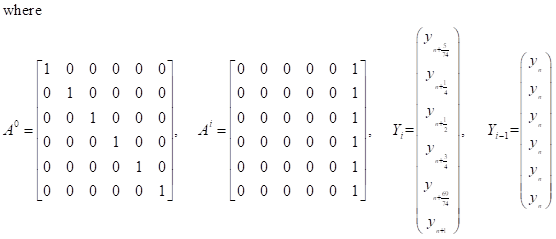
Following Lambert (1991), a method is said to be zero stable if the root ri of the first characteristic polynomial  does not exceed one (
does not exceed one ( ).
).
The first characteristic polynomial of the BHNTM is given by
The roots of (3.9) are  in which none of them is greater than one. Therefore, the BHNTM is zero-stable.
in which none of them is greater than one. Therefore, the BHNTM is zero-stable.
3.3 Consistency of the BHNTM
Definition 2, (Jator and Li, 2009). The linear multistep method (3.1) is said to be consistent if, it is of order  and its first and second characteristic polynomials defined as
and its first and second characteristic polynomials defined as
The discrete schemes derived are all of order greater than one and satisfies the conditions therein.
3.4 Convergence of the BHNTM
This section focuses on the discussion of the convergence analysis of the proposed BHNTM. By defining convergence, the proposed method is shown to be convergent by writing the formulas in (2.8) and (2.9) in an appropriate matrix notation form.
Definition 3 (Rufai and Ramos, 2021) Let  be the exact solution of the given second order boundary value problems and
be the exact solution of the given second order boundary value problems and  the approximate solutions obtained with the derived numerical technique. The proposed method is said to be convergent of order p if, for sufficiently small h, there exists a constant C independent of h, such that:
the approximate solutions obtained with the derived numerical technique. The proposed method is said to be convergent of order p if, for sufficiently small h, there exists a constant C independent of h, such that:
Note that in this circumstance,  .
.
Theorem 1 (Convergence theorem). Let y(x) denote the true solution of the second order BVP in (1.1) with boundary condition in (1.2), and  the discrete solution provided by the proposed method. Then, the proposed method is convergent to order seven.
the discrete solution provided by the proposed method. Then, the proposed method is convergent to order seven.
Proof. Following (Jator and Manathunga, 2018), suppose be matrix of dimension 

where the elements of Ai,j are 6*6 matrices as follows:

Suppose B be a 12N X 12N matrix defined by

where the elements of Bi,j are 6*6 matrices given as follows:


Bi,j=0 otherwise, where 0 is a zero matrix.
Hence,

Furthermore, the following vectors are defined as:

where T(h) is the local truncation error of order nine. The exact form of the system is given by
and the approximate form of the system is given by
where 
Subtracting (3.10) from (3.11) gives,
where  . Applying the mean-value theorem (Jator and Manathunga, 2018), which can be written as
. Applying the mean-value theorem (Jator and Manathunga, 2018), which can be written as
where JF is a Jacobian matrix. From this equation,  .
.
Hence, we obtain  , where
, where  and Ji,j are 6N*6N matrices.
and Ji,j are 6N*6N matrices.
 and Ji,j are 6N*6N matrices.
and Ji,j are 6N*6N matrices.Considering the matrix  , asserting that, for sufficiently small h,
, asserting that, for sufficiently small h,  is invertible. Observe that
is invertible. Observe that  Since
Since  ; it is enough to prove only the invertibility of
; it is enough to prove only the invertibility of  . The diagonal elements of
. The diagonal elements of  being non-zero certainly implies that its determinant is non-zero; hence, it is invertible. In fact, it is a lower triangular matrix. Therefore, is invertible. Let
being non-zero certainly implies that its determinant is non-zero; hence, it is invertible. In fact, it is a lower triangular matrix. Therefore, is invertible. Let  ,we have Q=A+Z then
,we have Q=A+Z then 
Let C=ZA-1 then  Note that, det(I-C) is the characteristic polynomial of C. Therefore,
Note that, det(I-C) is the characteristic polynomial of C. Therefore,  where φj are eigenvalues of C. For φ=1 gives
where φj are eigenvalues of C. For φ=1 gives 
If each  then
then  . Suppose that φj is an eigenvalue of
. Suppose that φj is an eigenvalue of  , then
, then  . If
. If  is proved successfully, then we are done. Thus, choosing
is proved successfully, then we are done. Thus, choosing  Therefore, there exists an h such that
Therefore, there exists an h such that  . Thus,
. Thus,  . This means that Q is invertible and
. This means that Q is invertible and  . Now,
. Now,  . This implies that QE=T(h) . Since Q is invertible,
. This implies that QE=T(h) . Since Q is invertible,  . Taking the maximum norm gives
. Taking the maximum norm gives  . Thus, the BHNTM is convergent, providing a seventh-order approximations.
. Thus, the BHNTM is convergent, providing a seventh-order approximations.
NUMERICAL EXPERIMENT
In this section, a range of numerical examples to demonstrate the accuracy of BHNTM are provided. The BHNTM was implemented using a code written in MAPLE 2015 and can be obtained from the authors. Moreover, the maximum absolute error of the approximate solution on  is calculated as
is calculated as  . The rate of convergence (ROC) is calculated using the formula
. The rate of convergence (ROC) is calculated using the formula  where
where  is the error derived through the step size h.
is the error derived through the step size h.
4.1 Implementation of the Proposed BHNTM
Step 1: choose  on the interval
on the interval  .
.
Step 2: using main method and additional method, for n=0 , generate a system of equations  on the sub-interval
on the sub-interval  and do not solve yet.
and do not solve yet.
 on the sub-interval
on the sub-interval Step 3: next, for n=1, generate a system of equations  on the subinterval
on the subinterval  , and do not solve yet.
, and do not solve yet.
 on the subinterval
on the subinterval Step 4: the process is continued for  until all the variables on the sub-interval
until all the variables on the sub-interval  are obtained.
are obtained.
Step 5: create a single block matrix equation to simultaneously obtain all solutions for (1.1) on the entire interval  obtained in step 3 and step 4.
obtained in step 3 and step 4.
The following notations are used:
BHNTM1,5: One-step Block Hybrid Nystrom-Type Method with five off-grid points
BNM: Block Nyström Method
Problem 1: Boundary value problem of Bratu-type equation
Consider the nonlinear Bratu equation of type (1.1) for μ = 1, with boundary conditions as:
where λ is taken as zero. The analytical solution to the above equation is:
 (4.2)
(4.2)where θ is the solution of the expression: θ=√2λ cosh((θ)/4). Such a Bratu Problem has zero, one, or two solutions for λ>λc, λ=λc and λ<λc respectively. The critical value λc satisfies the relation:
Zheng et al. (2014) reported that the critical value λc=3.513830719 The results for λ=1,2, and 3.51 are presented for Bratu BVP in Tables 2,3, 4 respectively. We solved the example using the step size h=0.1 to compare the absolute errors obtained with the ones given by the methods in Jator & Manathunga (2018); Jalilian (2010); and Liao & Tan (2007). It is obvious that our method (HBNTM) when compared with most of those reported in the literature. A very rapid change in the accuracy of the proposed method is observed by increasing the off-grid points in the system.
Table 3: Comparison of Absolute Error for Problem 1, when λ=1

Table 4: Comparison of Absolute Error for Problem 1 when λ=2
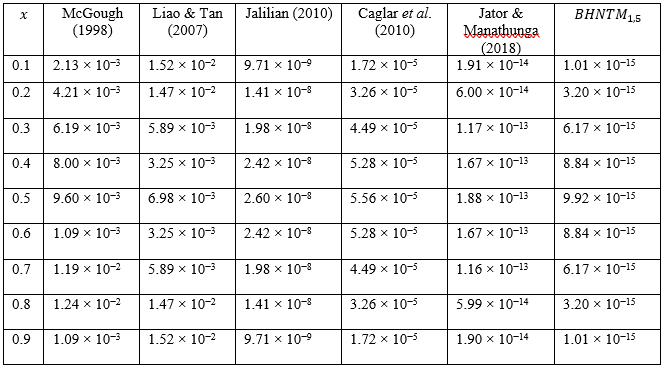
Table 5: Comparison of Absolute Error for Problem 1 when λ=3.51
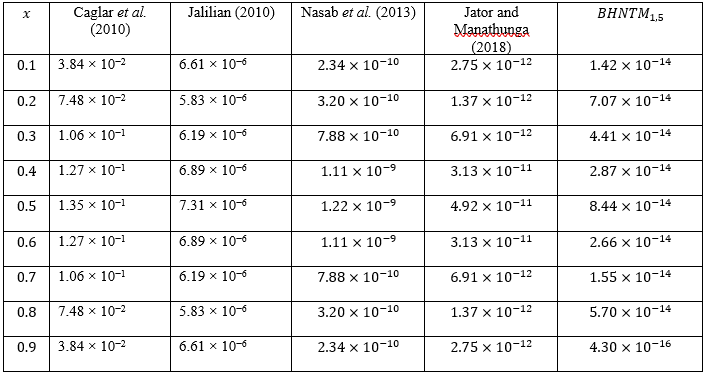
Problem 2: IVPs of Bratu-type equations
Consider the initial value problem of Bratu-type
with exact solution 
Source: Jator and Manathunga (2018)
Table 6: Maximum absolute error and rate of convergence for problem 2

Table 6 at different values of N, displays the maximum absolute errors obtained, the proposed BHNTM in comparison with the BNM in Jator and Manathunga (2018). This shows the superiority of the BHNTM. It is observed that the ROCs shows that the BHNTM behaves like an order seven (7) method, which is consistent to the theoretical order of the method p=7.
Table 7: Comparison of Absolute Error for problem 2

Table 7 at different values of x when N=10, displays the absolute errors obtained by different methods. By comparison, the BHNTM outperforms the methods found in literature.
RESULTS AND DISCUSSION
This paper describes the step-by-step implementation of the BHNTM, where a system of equations is generated on sub-intervals using block method approach of a continuous linear multistep method. These equations are not solved immediately, but instead, a block matrix equation is formed to obtain solutions simultaneously for the entire interval. This methodological approach ensures the accurate approximation of solutions to the Bratu-type equation.
The results of the numerical examples presented in the article demonstrate the effectiveness and accuracy of the proposed Block Hybrid Nystrom-Type Method (BHNTM) for solving the Bratu-type equation (4.1). The key findings are discussed in detail for each aspect:
A specific Bratu-type equation with boundary conditions, where λ is set to zero is considered. The analytical solution for this equation is given by equation (4.2), and it has zero, one, or two solutions based on certain conditions (as described in equation 4.3). The critical value of the parameter λ is also discussed in relation to the equation’s solutions.
Table 3 presents a comparison of the absolute errors for Problem 1 (Bratu-type equation) when λ=1. The results are compared with errors obtained from various other methods, including McGough (1998), Liao & Tan (2007), Jalilian (2010), Caglar et al. (2010), and Jator & Manathunga (2018). The BHNTM1,5 (Block Hybrid Nystrom-Type Method with five off-grid points) consistently demonstrates significantly lower absolute errors compared to other methods, indicating its superior accuracy.
Table 4 presents a similar comparison of absolute errors for Problem 1 when λ=2. Again, the BHNTM1,5 outperforms other methods in terms of accuracy, showcasing its robustness and efficiency.
Table 5 extends the comparison of absolute errors for Problem 1 to the case where λ=3.51. The BHNTM1,5 continues to exhibit remarkable accuracy, with absolute errors consistently lower than those obtained by other methods, including Caglar et al. (2010), Jalilian (2010), Nasab et al. (2013), and Jator & Manathunga (2018). The results confirm that the BHNTM is highly accurate even for different values of λ.
Overall, the numerical examples validate the accuracy and efficiency of the BHNTM in solving the Bratu-type equation. It consistently outperforms other methods across various scenarios, demonstrating its suitability for solving similar second-order nonlinear differential equations with boundary value problems. The rate of convergence (ROC) analysis, as mentioned in the article, further supports the BHNTM’s effectiveness in providing accurate solutions as the step size decreases. These findings contribute to the method’s credibility and applicability in scientific and engineering contexts where such equations arise.
Table 6 showcases the maximum absolute errors obtained using both the Block Nyström Method (BNM) from Jator and Manathunga (2018) and the proposed Block Hybrid Nystrom-Type Method (BHNTM) at different values of N, where N represents the number of iterations. The results clearly demonstrate the superiority of the BHNTM over the BNM in terms of accuracy.
The Rate of Convergence (ROC) analysis is performed, and it indicates that the BHNTM behaves like an order seven (7) method. This observed order of convergence (p=7) aligns with the theoretical order of the BHNTM method, confirming the method’s high accuracy.
Table 7 provides a comprehensive comparison of absolute errors for Problem 2 across various x values. These comparisons involve different methods, including Jalilian (2010), Raja et al. (2016) using Genetic Algorithm (GA), Active-Set Method (ASM), and RK4 Method (RKM), as well as Jator & Manathunga (2018), and the BHNTM1,5. The results highlight that the BHNTM1,5 consistently outperforms other methods across different x values, demonstrating its superior accuracy. Notably, the BHNTM1,5 achieves extremely low absolute errors, often reaching values close to zero, which indicates its high precision in approximating the exact solution.
In summary, the results findings for Problem 2 affirm the exceptional accuracy and efficiency of the BHNTM in solving initial value problems of Bratu-type equations. The method consistently outperforms other numerical methods, demonstrating its potential as a reliable and accurate solver for such nonlinear differential equations. The Rate of Convergence analysis further supports the BHNTM’s theoretical order of convergence, reinforcing its credibility as a numerical method for scientific and engineering applications where precision is crucial.
CONCLUSION
The well-known Bratu problems arise in different variety of applications and many researchers have drawn attention to solve them. The difficulties that exist in these problems due to the strong nonlinear terms is overcome here. The main characteristics of the proposed method is solving the problem without reducing them into their initial value equivalent, taking away the computational burdens and time wastage attached to them. It is also observed that increasing the off-grid points results in improved accuracy. Numerical results confirmed that the BHNTM is preferred to reported methods in literature in terms of accuracy and consistency.
Declaration of Competing Interest
The authors declare that there is no known conflicting interests.
REFERENCES
- Bratu, G. (1914): Sur les équations integrals non linéaires. Bulletin de la Société Mathématique, de France, 42 (1), 113-142.
- Buckmire, R. (2004). Applications of Mickens finite differences to several related boundary value problems in: Advances in the Applications of Nonstandard Finite Difference Schemes, 47-87.
- Caglar, H., Caglar, N. Ozer, M., Valaristos A., and Anagnostopoulos A. N. (2010). B-spline method for solving Bratu’s problem. International Journal of Computer Mathematics, 87 (8), 1885-1891.
- Deeba, E., Khuri, S. A., & Xie, S. (2000): An Algorithm for Solving Boundary Value Problems. Journal of Computational Physics, 159(2), 125–138. https://doi:10.1006/jcph.2000.6452
- Frank-Kamenetski, D.A. (1955): Diffusion and Heat exchange in chemical kinetics. New Jersey, Princeton, Princeton Unversity Press.
- Gel’fand, I.M. (1963): Some problems in the theory of quasi-linear equations. American Mathematical Society Translation Series, 2(29), 295-381.
- Hassan, I. H. A. H. & Erturk, V. S. (2007): Applying differential transformation method to the one-dimensional planar Bratu problem, International Journal of Contemporary Mathematical Sciences, 2, 1493-1504.
- Hariharan, G., & Pirabaharan, P. (2013): An Efficient Wavelet Method for Initial Value Problems of Bratu-Type Arising in Engineering, Applied Mathematical Sciences. 7(43) 2121-2130.
- Jacobsen, J., & Schmitt, K. (2002): The Liouville–Bratu–Gelfand Problem for Radial Operators. Journal of Differential Equations, 184(1), 283–298. https://doi:10.1006/jdeq.2001.4151
- Jalilian, R. (2010). Non-polynomial spline method for solving Bratu’s problem. Computer Physics Communications, 181(11), 1868-1872.
- Jator, S. N., & Li, J. (2009). A self-starting linear multistep method for a direct solution of the general second order initial value problems. International Journal of Computer Mathematics, 86(5), 827-836.
- Jator, S. N., & Manathunga, V. (2018). Block Nystr ¨om type integrator for Bratu ’ s equation. Journal of Computational and Applied Mathematics. https://doi.org/10.1016/j.cam.2017.06.025
- Lambert, J.D. (1991). Numerical methods in ordinary differential systems. (Vol. 146). New York: John Wiley and Sons.
- Liao, S., & Tan, Y. (2007). A General Approach to Obtain Series Solutions of Nonlinear Differential Equations. Studies in Applied Mathematics, 119(4), 297-354.
- McGough, J. S. (1998): Numerical continuation and the Gelfand problem. Applied Mathematics and Computation, 89(1-3), 225–239. https://doi:10.1016/s0096-3003(97)81660
- Mounim, A.S., de Dormale, B.M. (2006): From the fitting techniques to accurate schemes for the Liouville-Bratu-Gelfand problem. Journal of Numerical Methods and Partial Differentiatial Equation, 22(4), 75-76.
- Mohsen, A. (2014). A Simple Solution of the Bratu Problem. Computers and Mathematics with Applications, 67(1), 26 – 33.
- Nasab Kazemi, A., Pashazadeh Atabakan, Z., & Kılıçman, A. (2013). An efficient approach for solving nonlinear Troesch’s and Bratu’s problems by wavelet analysis method. Mathematical Problems in Engineering, 2013.
- Raja, M.A.Z., Khan, J.A., Haroon, T. (2015): Stochastic Numerical Treatment for thin film flow of third grade fluid using unsupervised neural networks. Journal of Taiwan Institute of Chemical Engineering 48(1), 26-39. https://doi.org/10.1016/j.jtice.2014.10.018
- Raja, M. A. Z., Samar, R., Alaidarous, E. S., & Shivanian, E. (2016). Bio-inspired computing platform for reliable solution of Bratu-type equations arising in the modelling of electrically conducting solids. Applied Mathematical Modelling, 40(11-12), 5964-5977.
- Rufai, M.A., & Ramos, H. (2020). Numerical solution of Bratu’s and related problems using a third derivative hybrid block method. Computational and Applied Mathematics. 39 (4), 322.
- Rufai, M.A., & Ramos, H. (2021). Numerical solution for singular boundary value problems using a pair of hybrid Nyström techniques. Axioms, 10(3), 202.
- Temimi, H., & Ben-Romdhane, M. (2016): An iterative finite difference method for solving Bratu’s problem. Journal of Computational and Applied Mathematics, 292, 76–82. https://doi:10.1016/j.cam.2015.06.023
- Wazwaz, A.M & Suheil, K.A. (2013): A Variational Approach to a BVP Arising in the Modelling of Electrically Conducting Solids. Central European Journal of Engineering 3(1), 106-112.
- Zheng, S., Jingjing, L., & Hongtao, W. (2014): Genetic algorithm based wireless vibration control of multiple modals for a beam by using photo-strictive actuators. Journal of Applied Mathematical Modelling, 38(2), 437-450.

